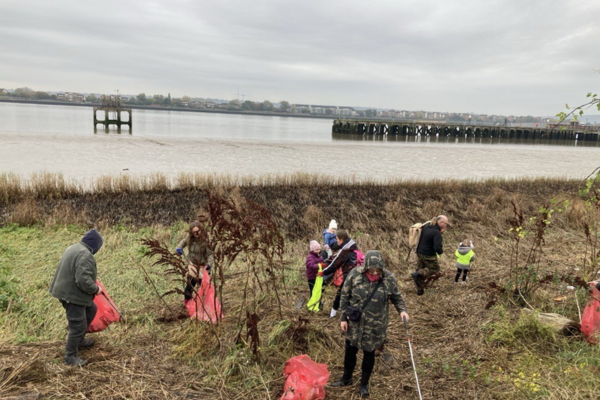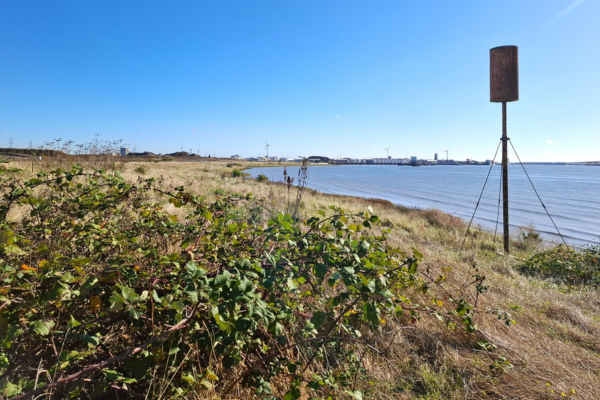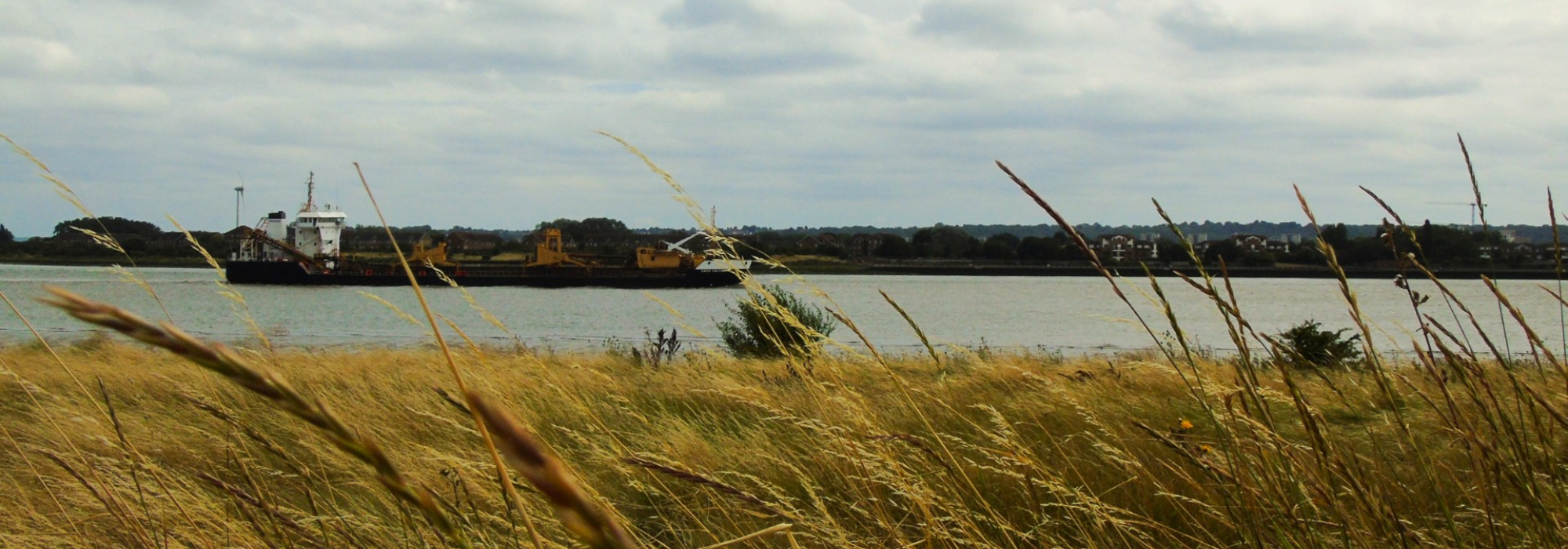Footpath 47: A natural and social sanctuary under threat
Finding places of sanctuary and solitude in London is becoming increasingly difficult as riversides rapidly transform due to ‘bricks and mortar’ development projects. Yet in a small corner of East London, the Barking riverside offers one of the city’s quieter, wilder spots. Footpath 47, a public right of way, is home to wildflowers, grassland and saltmarshes. Its birdlife consists of avocets, skylarks, reed buntings and linnets amongst many others. As a sanctuary to wildlife, the river space offers Barking residents a rare connection to nature. Further symbolic of the people’s character and history lie the old navigational beacons that impose themselves on the riverside, furthering a sense of the area’s maritime heritage.
 However, the space will radically transform into one of London’s largest development project plans that promises 20,000 new homes in the borough. While promising to bring amenities to the area, the development will nonetheless extend to the shoreline, making it unrecognisable and replacing the riverside footpath’s natural landscape with dense high-rise buildings and upmarket housing.
However, the space will radically transform into one of London’s largest development project plans that promises 20,000 new homes in the borough. While promising to bring amenities to the area, the development will nonetheless extend to the shoreline, making it unrecognisable and replacing the riverside footpath’s natural landscape with dense high-rise buildings and upmarket housing.
In response to this, nearby residents from the Thames View estate have formed the Friends of Footpath 47, a group campaigning for its conservation. Their aim is to promote sustainable development that incorporates the natural space while honouring the space’s heritage. The campaign originates from a deep sense of place and belonging to an area where memories are rooted in lived experiences and shared histories, demonstrating an ability to bridge social and environmental justice.
Nature as Social Justice
Barking & Dagenham is one of London’s most deprived boroughs, and the social value of this river space becomes more important when considering its scarcity. Evidence submitted to a parliamentary committee reveals that deprived areas in the UK have five times less green/blue space per person than affluent communities (parliament.uk, 2023). This significantly affects lower-income and underrepresented communities, highlighting how environmental and social inequalities are connected to one another. This has been acknowledged by London’s own Deputy Mayor of Environment, Mete Coban who stated earlier this year: “Access to nature is a social justice issue. We see many parts of London where people do not have access to good quality green and blue spaces” (London Assembly, 2025).
The importance of these spaces is shared by Friends of Footpath 47 members Kevin Hudson and Marion Hull. Longtime residents of Barking, they recognise the importance of this natural space in cultivating community. Commenting together, they stated: “They’re important not just for what’s there for nature, but because they bring people together and mean something special to the community where it’s most needed”.
The campaign illustrates these objections primarily because it speaks of a fear of breaking community ties that have defined the area, the type of marginalisation working class communities has experienced too often in recent decades. Unfortunately, it is part of a wider trend across the Thames in recent decades. In 2003, the GLA Assembly Member John Biggs commented in a report titled Access To The Thames about his concern that the “Thames is being barricaded from the rest of London by riverside developments that fail to consider how they relate to the river and its immediate hinterland”.
Grassroots Activism Rooted in Identity

Friends of Footpath47 demonstrate the impact of how such developments can break the connection between nature and community. For these residents, the local environment feels like an extension of themselves. This very personal and localised form of environmental stewardship offers an alternative to more abstract national or global environmental campaigns and debates. Pete Miller is a long-term resident of Barking, having been born and bred in the borough. His motivation to protect the space comes from a deep attachment rooted in childhood memories. His emotional engagement emphasises the importance of ensuring access to nature for future generations. We used to bring our bikes here and play all day by the dunes of landfill. All of it eventually became colonised by grasslands and the wildlife that we see here today”.
The group’s activism, including community meetings, consultations, and discussion with developers, tries to ensure local leadership and representation on the issue. But despite engagement efforts from developers, there is a nagging feeling that these processes are tokenistic, providing further disillusion between communities and stakeholders supposed to represent them. These frustrations are exacerbated by a feeling of negative perceptions towards their social class. Kevin claims “I think it’s a class issue, because we’re working-class fodder, it’s easier to get away with it”.
The fact that this perception exists underlines the earlier point that limiting or removing access to nature is a social justice issue, further highlighting the limitations working–class communities face. For marginalised communities such as this one, a lack of social networks and access to decision makers creates a distance between the community and developers, making it harder for them to organise around the issues they care for. This is exacerbated by an increasing lack of community infrastructure and social spaces for convening. While community spaces do exist (and are utilised by many in the group, such as the local Curzon Centre by the Thames View estate), they ‘are becoming few and far between’ according to Kevin. “Spaces that galvanise a community are the catalyst for good organisation… our community is a lot more disparate through lack of community spaces”. Because of added social pressures such as lack of time and resources, being seen and heard is more difficult for those in working-class communities.
Active Stewardship and Collective Care
This sense of disempowerment was acknowledged by the UK government in 2019. Their Community Resilience Development Framework encouraged integrating the public’s input and capabilities into planning to promote resilience and cohesion. Recommended good practice is neglected however, as current measures to consult the community feel tokenistic. A power imbalance is felt when the community is asked to respond to environmental assessments, which span hundreds of volumes. They are expected to reply to these documents within a few weeks, a deadline they feel is unrealistic. Furthermore, according to Dr Dan Taylor, “the project’s encroachment on Footpath 47 disregards the space as an asset for community resilience and cohesion”.
 Still, this lack of inclusion only galvanises the community to take control of their own narrative. The residents demonstrate their protest through positive, active stewardship such as photo campaigns, public talks and river clean-ups. Instead of just opposing development, the residents have created a positive narrative around the space.
Still, this lack of inclusion only galvanises the community to take control of their own narrative. The residents demonstrate their protest through positive, active stewardship such as photo campaigns, public talks and river clean-ups. Instead of just opposing development, the residents have created a positive narrative around the space.
Regarding river clean ups, Marion, who leads the Roding Rubbish litter clean–up group, says that community efforts in protecting the environment “make you feel part of something bigger than yourself, and creates greater identification with other groups”. For Marion, the loss of Footpath 47 will mean a further disconnect between community and the environment, discouraging opportunities for pro-environmental behaviours at a time when these are desperately needed. But their collective efforts reinforce a shared purpose and sense of belonging that has helped bridge divides with various groups, community organisations and faith groups in encouraging cooperation and social cohesion. As such, their environmentalism gains greater resonance when combined with issues of social justice.
Making Urban Nature Accessible – Lessons Upstream
Friends of Footpath 47’s concerns are not just isolated to their own area but towards a wider concern for riverscapes. Further upstream into central London, they see developments commercialising the river space, limiting public spaces and gentrifying once working-class areas into gated communities. The commodification of these spaces, making them privatised, exclusive, and a luxury, is the primary fear of the community.
The community fears this process will also cut people off from vital spaces that support wellbeing and connection, citing examples of high-density developments upstream that already impede river access. They believe there must be a genuinely sustainable balance that prioritises both human and ecological needs, especially by maintaining the accessibility of natural areas like Footpath 47. As Kevin explained: “Equitable spaces should be the emphasis. Developments that cater to everyone and wildlife, basically everything”.
The campaign to protect Footpath 47 demonstrates that people and place are intrinsically linked. For these residents, the local environment is more than a luxury backdrop; it is central to their identity, fostering a deep sense of wellbeing and community spirit. Losing this connection, for both current and for future generations, will create greater barriers to environmental protection, making nature feel abstract and impersonal and weakening the will to act.
Friends of Footpath 47 shows that when natural spaces are protected as places of belonging, the divide between environmental and social justice can be bridged, proving they are a vital resource that promotes community cohesion. These unique spaces, therefore, sustain and nurture not only nature but also the people that live there.
By Matt Dawson, Thames Connections Project Coordinator at Thames21.
Correction
The article was originally published on 6th November 2025 and mentioned that “the developers own environmental assessment admits to ‘substantial loss in the extent of open sky visible and the composition of the view will be dramatically altered.’” Barking Riverside Limited has since then clarified that this referred to “the perspective from Thamesmead, across the river, rather than from Footpath 47 itself.” This paragraph has, therefore, been removed.
Right to Reply
Barking Riverside Limited said:
“We can confirm that Footpath 47 will remain and is not at risk.
BRL’s proposals were unanimously approved at planning committee in July, with members noting the benefits to residents. Throughout our consultations we have received largely positive feedback, with 75% of those we engaged with saying the objective of ‘Conserving Ecology’ had been ‘very well addressed’ or ‘well addressed’.
BRL’s new Outline Planning Application for Barking Riverside must produce a minimum of 10% biodiversity net gain in comparison to what already exists. Therefore, if the proposals did not offer a significant biodiversity net gain, the scheme would not have been granted approval.
The proposals deepen the coastal grassland areas on the foreshore – not just protecting the existing habitat, but enhancing it to create improved conditions for nesting birds and other wildlife. Further, a meandering path will be safe and flat for those with mobility issues and buggies, making the riverfront more accessible to more members of the public. Other benefits include a new terrace by the pier, providing space to meet, greet and spend time enjoying the river, and new play areas for children of all ages.
We respect Friends of Footpath 47’s passion for the area and have regularly invited the group to meet with us to discuss their concerns and to address the misinformation surrounding the proposals. We have not yet had a response to any of our requests for a meeting, but we will be happy to meet with the group once they respond to our correspondence.”
